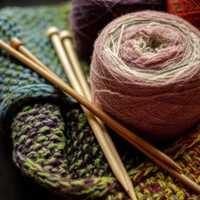Discover the Joys and Benefits of Quilting. An Inspirational and Creative Form of Craft
By Rose Mary
By Rose Mary
Quilting was a common social activity in the past. During earlier times, quilting fabric was an activity which farm wives like to get together to do. These are opportunities for them to retreat from their straining physical chores of farm life and do something light and useful together. At that time, quilts were an essential article in households, not only as bed coverings, but also as curtains, and petticoats and waistcoats to keep the body warm. In fact, patchwork quilting was created by homemakers during the time when there was a shortage of fabric. Worn out sewn items were often recycled into patches for quilts.
Today, quilting is no longer practiced to satisfy economic or social needs, but for expression and enjoyment. Patchwork is not longer simply a form of frugality, but rather another form of art. Although quilts are still sometimes made from fabric scraps, the quilt maker is more likely to use the scraps to recreate the charming look of old quilts or to commemorate an event, rather than out of necessity. Quilting is now used as a creative and inspirational form of craft. Having a long history, quilting has shown itself to be admirably versatile and its ability to change and adapt is a hallmark of a successful craft.
Many people, today, used quilting as a hobby because they find it fun, gratifying and enriching. Quilting offers them an opportunity to express their creativity and helps to enhance their lives. Most people enjoy the process of choosing or designing a project, the process of selecting the fabrics and the satisfaction of creating something unique and special. It gives them an opportunity to experiment with color, design and texture. The completed piece of quilt gives the maker a great sense of achievement and delight. Most people engage in quilting because they want a creative experience and an emotional expression. It is no wonder that some people find it healing. Stressed mothers of young children, exhausted caregivers of ill parents, wearied working women and men seeking a creative outlet often find the process of making something soft and warm, like quilt, is more restorative than the usage of any kind of available drugs.
As quilts provide warm and comfort, they are used for clothing and bed coverings. There are those which are kept as attractive works of art. They have been showcases for the talents and skills of their creators. The range of quilted items, nowadays, has expanded to include placemats, wall hangings, cushion covers, table runners, bonnets, diaper totes, eyeglass cases, makeup bags and hanger covers.
Making quilts today is easier than you may have ever imagined. The making of quilts does not require any special skills, just a general knowledge of sewing. If you can sew a button or mend a hem, you can certainly make a quilt. Quilting is simply using a technique to stitch together layers of fabric using a decorative pattern to create a variety of beautiful and practical objects. A completed quilt is actually a creatively stitched together sandwich of fabric and batting. The basic equipment for quilting include needles, pins, thread, scissors, thimble, beeswax and a frame or hoop to quilt on. Other necessities are a long ruler, masking tape, drawing paper and a marker for transferring quilt patterns onto fabric. Although machine techniques may have replaced the tedious hand sewing one, modern quilt makers still take inspiration from old quilts and try to adapt those designs and techniques to today’s lifestyles.
It is important that while working on selected quilting patterns, a quilt maker should not just replicate the patterns and colors shown in the samples but also to adapt the patterns to his or her own color preferences and ideas. He or she should attempt to create his or her own unique designs and try out new techniques. In this way, he or she can make progress by gaining new technical skills as well as new insights into the design process.
More information on quilting techniques can be obtained from the link:- Benefits of Quilting
Rose Mary
Appreciate quilting Benefits of Quilting
Article Source: http://EzineArticles.com/?expert=Rose_Mary
Quilting was a common social activity in the past. During earlier times, quilting fabric was an activity which farm wives like to get together to do. These are opportunities for them to retreat from their straining physical chores of farm life and do something light and useful together. At that time, quilts were an essential article in households, not only as bed coverings, but also as curtains, and petticoats and waistcoats to keep the body warm. In fact, patchwork quilting was created by homemakers during the time when there was a shortage of fabric. Worn out sewn items were often recycled into patches for quilts.
Today, quilting is no longer practiced to satisfy economic or social needs, but for expression and enjoyment. Patchwork is not longer simply a form of frugality, but rather another form of art. Although quilts are still sometimes made from fabric scraps, the quilt maker is more likely to use the scraps to recreate the charming look of old quilts or to commemorate an event, rather than out of necessity. Quilting is now used as a creative and inspirational form of craft. Having a long history, quilting has shown itself to be admirably versatile and its ability to change and adapt is a hallmark of a successful craft.
Many people, today, used quilting as a hobby because they find it fun, gratifying and enriching. Quilting offers them an opportunity to express their creativity and helps to enhance their lives. Most people enjoy the process of choosing or designing a project, the process of selecting the fabrics and the satisfaction of creating something unique and special. It gives them an opportunity to experiment with color, design and texture. The completed piece of quilt gives the maker a great sense of achievement and delight. Most people engage in quilting because they want a creative experience and an emotional expression. It is no wonder that some people find it healing. Stressed mothers of young children, exhausted caregivers of ill parents, wearied working women and men seeking a creative outlet often find the process of making something soft and warm, like quilt, is more restorative than the usage of any kind of available drugs.
As quilts provide warm and comfort, they are used for clothing and bed coverings. There are those which are kept as attractive works of art. They have been showcases for the talents and skills of their creators. The range of quilted items, nowadays, has expanded to include placemats, wall hangings, cushion covers, table runners, bonnets, diaper totes, eyeglass cases, makeup bags and hanger covers.
Making quilts today is easier than you may have ever imagined. The making of quilts does not require any special skills, just a general knowledge of sewing. If you can sew a button or mend a hem, you can certainly make a quilt. Quilting is simply using a technique to stitch together layers of fabric using a decorative pattern to create a variety of beautiful and practical objects. A completed quilt is actually a creatively stitched together sandwich of fabric and batting. The basic equipment for quilting include needles, pins, thread, scissors, thimble, beeswax and a frame or hoop to quilt on. Other necessities are a long ruler, masking tape, drawing paper and a marker for transferring quilt patterns onto fabric. Although machine techniques may have replaced the tedious hand sewing one, modern quilt makers still take inspiration from old quilts and try to adapt those designs and techniques to today’s lifestyles.
It is important that while working on selected quilting patterns, a quilt maker should not just replicate the patterns and colors shown in the samples but also to adapt the patterns to his or her own color preferences and ideas. He or she should attempt to create his or her own unique designs and try out new techniques. In this way, he or she can make progress by gaining new technical skills as well as new insights into the design process.
More information on quilting techniques can be obtained from the link:- Benefits of Quilting
Rose Mary
Appreciate quilting Benefits of Quilting
Article Source: http://EzineArticles.com/?expert=Rose_Mary



